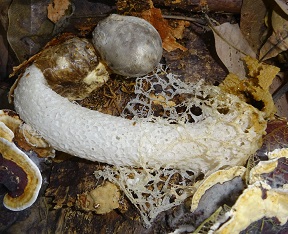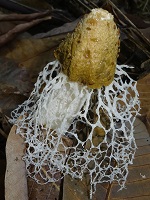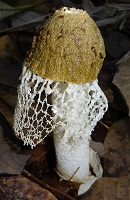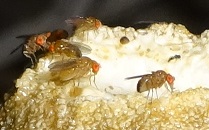| Home | Nature Weekly Index |
3 May 2015 | Stinkhorn Mushrooms (Phallus species) |
 It had been raining consistently at certain part of the days over the last two weeks. The wet soil surface at the park, especially
those covered with thick layers of leaf litter, was now a fertile ground for mushrooms. Mushrooms were common in this park,
especially the Split Gill (Schizophyllum commune), that colonized
decaying trunks of the Rubber Tree (Hevea brasiliensis). The more exotic
mushroom species were harder to come by. One of them was the Stinkhorn Mushroom.
It had been raining consistently at certain part of the days over the last two weeks. The wet soil surface at the park, especially
those covered with thick layers of leaf litter, was now a fertile ground for mushrooms. Mushrooms were common in this park,
especially the Split Gill (Schizophyllum commune), that colonized
decaying trunks of the Rubber Tree (Hevea brasiliensis). The more exotic
mushroom species were harder to come by. One of them was the Stinkhorn Mushroom.

 I knew this park harboured Stinkhorn Mushroom as I once saw a remnant of it a few years back. It was not until last Saturday that
I saw my next Stinkhorn Mushroom in this location. But, it had already collapsed on the ground. What excite me was the small
greyish spherical body beside its foot. It appeared to be an immature fruiting body of the mushroom. Beside it was an large bracket
mushroom, likely a Earliella scabrosa from the family Polyporaceae.
The bracket mushroom was seated on a discarded tree stump while the Stinkhorn Mushroom was nested on top of the thick layers of
leaf litter.
I knew this park harboured Stinkhorn Mushroom as I once saw a remnant of it a few years back. It was not until last Saturday that
I saw my next Stinkhorn Mushroom in this location. But, it had already collapsed on the ground. What excite me was the small
greyish spherical body beside its foot. It appeared to be an immature fruiting body of the mushroom. Beside it was an large bracket
mushroom, likely a Earliella scabrosa from the family Polyporaceae.
The bracket mushroom was seated on a discarded tree stump while the Stinkhorn Mushroom was nested on top of the thick layers of
leaf litter.

I decided to try my luck again the next day to check on the immature fruiting body, hoping that it would sprout to life. There was no sign of change to the spherical body. However, my luck had not run out --- a newly emerged Stinkhorn Mushroom was standing nearby ready for my admiration. Indeed, it was a spectacular piece of work by Mother Nature. As if one was not enough, another erected mushroom was just standing within half a metre radius. I had to count myself very lucky to see a few such mushrooms in a day. Plenty of red-eyed Drosophila flies could be seen on the apex region (cap) of the mushrooms. These flies helped with the dispersion of the mushroom spores.
.jpg)
.jpg) At first, I thought they are Phallus indusiatus. But, the pattern of
the cap looked different. Phallus indusiatus is supposed to have a reticulated cap --- pattern of interlacing lines. The
ones that I just saw were without reticulated caps. They were likely to be
Phallus merulinus instead. In addition, Phallus merulinus has a
shorter indusium (basket).
At first, I thought they are Phallus indusiatus. But, the pattern of
the cap looked different. Phallus indusiatus is supposed to have a reticulated cap --- pattern of interlacing lines. The
ones that I just saw were without reticulated caps. They were likely to be
Phallus merulinus instead. In addition, Phallus merulinus has a
shorter indusium (basket).
In rare occasions, I did come across Stinkhorn Mushrooms in the forest. The Phallus indusiatus shown was spotted at the Dairy Farm Nature Park in August 2013. The most amazing Stinkhorn Mushroom that I had seen locally was one with an orange cap and pink basket at the MacRitchie Reservoir area in September 2013. Sadly, I found the mushroom after a heavy downpour where most of the basket structure had been destroyed by the rain. While I was taking photo of the remaining orange cap mushroom, a lady came by and showed me her mobile with a picture of the mushroom taken before the rain. It was really magnificent and beautiful. It is likely to be a Phallus multicolor.